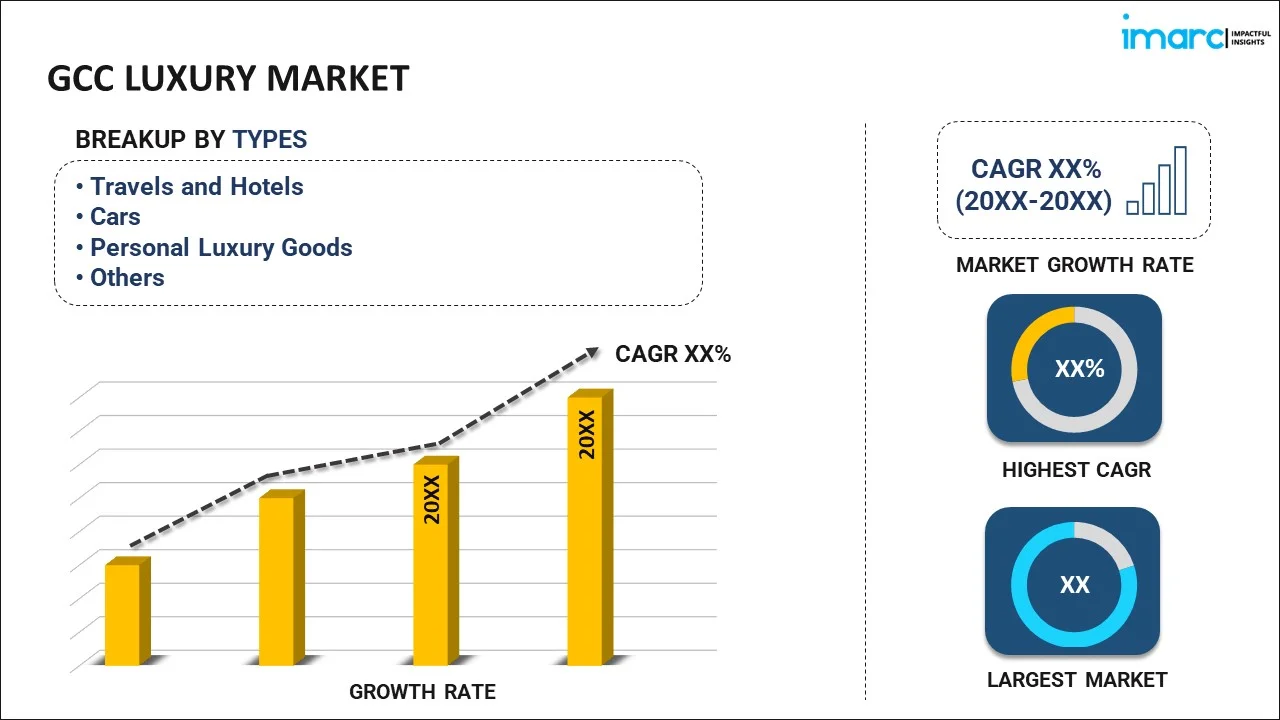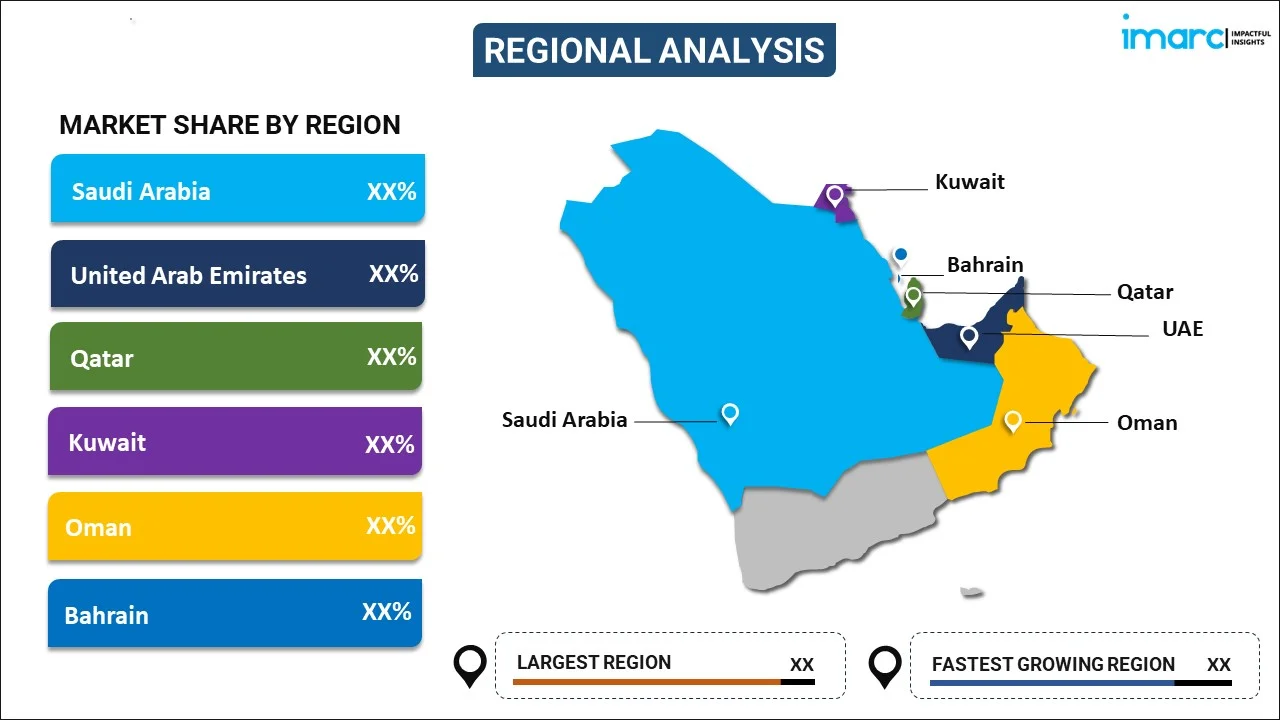
GCC Luxury Market Report by Type (Travels and Hotels, Cars, Personal Luxury Goods, Food and Drinks, and Others), Gender (Male, Female), Distribution Channel (Mono-Brand Stores, Multi-Brand Stores, Online Stores, and Others), and Region 2025-2033
Market Overview:
The GCC luxury market size reached USD 16.9 Billion in 2024. Looking forward, IMARC Group expects the market to reach USD 37.6 Billion by 2033, exhibiting a growth rate (CAGR) of 8.79% during 2025-2033.
|
Report Attribute
|
Key Statistics
|
|---|---|
|
Base Year
|
2024
|
|
Forecast Years
|
2025-2033
|
|
Historical Years
|
2019-2024
|
| Market Size in 2024 | USD 16.9 Billion |
| Market Forecast in 2033 | USD 37.6 Billion |
| Market Growth Rate 2025-2033 | 8.79% |
The GCC luxury market is currently being catalysed by rising economic growth, a large young population, strong growth of the tourism sector, and an increasing penetration of ecommerce and social media.
In a region made affluent from strong oil production and exports, GCC economies have experienced strong economic growth over the past decades. Catalysed by rising affluence levels, spending on luxury products has been witnessing a continuous growth. The region has also witnessed strong population growth over the last five years resulting in a large young population. Currently around half of the total population in the region is below 30 years of age. With this generation of the population being bought up during the region’s economic ascendency, they perceive luxury not given but as a gift. It is the young population that represents the biggest driver of the luxury market in the region.
Another major driver of the luxury market in the region is the increasing penetration of ecommerce and social media. The online market continues to drive the sales of luxury products as boundaries blur with the more traditional distribution channels. Social media platforms such as youtube, facebook, instagram, whatsapp, etc. are also influencing consumers, particularly the younger generation. Moreover, the tourism sector of the GCC region has also been expanding in nations like the UAE which has further broadened the growth prospects for luxury goods.
Key Market Segmentation:
IMARC Group provides an analysis of the key trends in each sub-segment of the GCC luxury market report, along with forecasts at the regional and country level from 2025-2033. Our report has categorized the market based on type, gender and distribution channel.
Breakup by Type:

- Travels and Hotels
- Cars
- Personal Luxury Goods
- Food and Drinks
- Others
Currently, the cars category dominates the market.
Breakup by Gender:
- Male
- Female
On the basis of gender, males dominated the market.
Breakup by Distribution Channel:
- Mono-Brand Stores
- Multi-Brand Stores
- Online Stores
- Others
Based on the distribution channel, the GCC luxury market has been segmented into mono-brand stores, multi-brand store, online stores and others.
Breakup by Region:

- Saudi Arabia
- United Arab Emirates
- Qatar
- Kuwait
- Oman
- Bahrain
Saudi Arabia and UAE are the prominent regions.
Competitive Landscape:
The competitive landscape of the industry has also been examined along with the profiles of the key players.
This report provides a deep insight into the GCC luxury market covering all its essential aspects. This ranges from macro overview of the market to micro details of the industry performance, recent trends, key market drivers and challenges, SWOT analysis, Porter’s five forces analysis, value chain analysis, etc. This report is a must-read for entrepreneurs, investors, researchers, consultants, business strategists, and all those who have any kind of stake or are planning to foray into the GCC luxury industry in any manner.
Report Coverage:
| Report Features | Details |
|---|---|
| Base Year of the Analysis | 2024 |
| Historical Period | 2019-2024 |
| Forecast Period | 2025-2033 |
| Units | Billion USD |
| Segment Coverage | Type, Gender, Distribution Channel, Country |
| Countries Covered | Saudi Arabia, UAE, Qatar, Oman, Kuwait, Bahrain |
| Customization Scope | 10% Free Customization |
| Post-Sale Analyst Support | 10-12 Weeks |
| Delivery Format | PDF and Excel through Email (We can also provide the editable version of the report in PPT/Word format on special request) |
Key Questions Answered in This Report
The GCC luxury market was valued at USD 16.9 Billion in 2024.
We expect the GCC luxury market to exhibit a CAGR of 8.79% during 2025-2033.
The sudden outbreak of the COVID-19 pandemic has led to the changing consumer inclination from conventional brick-and-mortar distribution channels towards online retail platforms for the purchase of luxury products across several GCC nations.
The growing presence of various international luxury brands, along with the increasing penetration of ecommerce and social media influence, is primarily driving the GCC luxury market.
Based on the type, the GCC luxury market can be categorized into travels and hotels, cars, personal luxury goods, food and drinks, and others. Currently, cars account for the majority of the total market share.
Based on the gender, the GCC luxury market has been segregated into male and female, where male currently holds the largest market share.
Based on the distribution channel, the GCC luxury market can be bifurcated into mono-brand stores, multi-brand stores, online stores, and others. Currently, mono-brand stores exhibit a clear dominance in the market.
On a regional level, the market has been classified into Saudi Arabia, United Arab Emirates, Qatar, Kuwait, Oman, and Bahrain, where United Arab Emirates currently dominates the GCC luxury market.
Need more help?
- Speak to our experienced analysts for insights on the current market scenarios.
- Include additional segments and countries to customize the report as per your requirement.
- Gain an unparalleled competitive advantage in your domain by understanding how to utilize the report and positively impacting your operations and revenue.
- For further assistance, please connect with our analysts.
 Inquire Before Buying
Inquire Before Buying
 Speak to an Analyst
Speak to an Analyst
 Request Brochure
Request Brochure
 Request Customization
Request Customization




.webp)




.webp)












